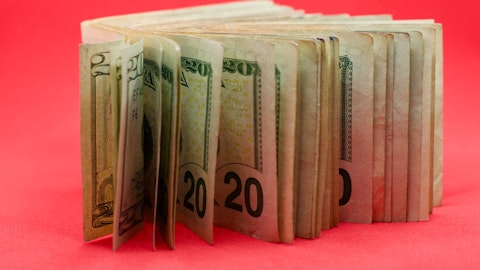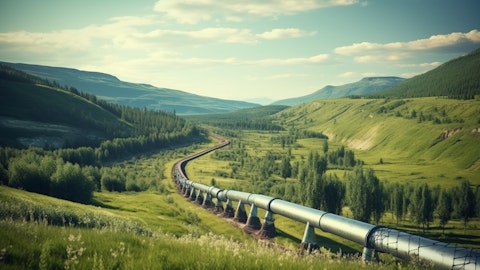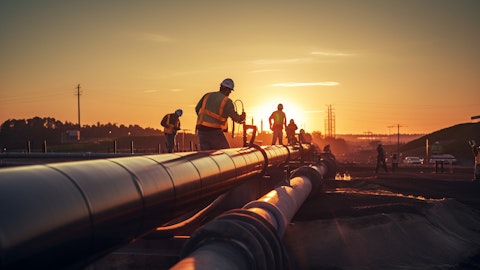We just put PDH 2 into service in 2023. That was another lumpy project. So just don’t foresee a lot of those lumpy projects coming with the exception of SPOT.
Theresa Chen: Got it. Thank you.
Randy Fowler: I think with SPOT that’s probably a 3-year construction cycle.
Theresa Chen: Understood. And in terms of projects that are coming online near term for your Texas West product system, can you remind us how much of that is underwritten by third party commitments versus open capacity that you hope to market and capture that ARB, especially in light of the fact that, since you announced the project, one of your midstream competitors who also has significant marketing capabilities bought a huge refined product system and is also looking to close PAD 2 and PAD 4 ARBs.
Justin Kleiderer: Hey, Theresa, it’s Justin Kleiderer again. And Tug may chime in on a piece of that as well. But as we develop the project, it’s really it really has developed into really a rack marketing model. We had the first phase of startup really impending and the timing of the rest of it should be lined out in the deck. But we’ve got significant interest. We’ve got 40 third party contracts agreed to across the terminals and we’re signing up more seemingly daily. So people are just itching for it to come on. But we do think similar to Dixie and our legacy propane long haul pipelines being sort of an uncontracted rack-based model, that that’s the model that we’re going to see on TW.
Theresa Chen: Thank you.
Operator: Thank you. One moment for questions. Our next question comes from Jeremy Tonette with JPMorgan Securities. You may proceed.
Jeremy Tonet: Hi, good morning. And Randy, I want to wish you congratulations here. Good luck with everything going forward. You will be missed, and thank you.
Randy Burkhalter: Thank you, Jeremy.
Jeremy Tonet: And I just wanted to start off, I guess, with the recent Houston ship channel enhancements that we’ve seen over time here. I’m wondering if you could comment on how that’s impacted your LPG export capabilities. Have you seen any kind of improvements there given the changes? Just curious how that has developed.
Robert Sanders: Yes, this is Bob Sanders. Late in the fourth quarter last year, the Houston pilots removed the daylight restriction on LPG ships. So we can sail 24 hours a day loaded or empty. And we are incrementally picking up the number of vessels we’re bringing in to try to maximize the utilization of the refrigeration units that we’ve got right now. So we are seeing a direct benefit.
Jeremy Tonet: Got it. Just curious if that’s a minor or maybe, bigger expansion. And also, Tony, I guess I’m curious, I guess, with thoughts on LPG pricing here. I guess there’s a concern in the marketplace that LPG exports might be maxed out and that could dislocate domestic pricing relative to international price markers. So just wondering how you see that playing out.
Tony Chovanec: I’ll answer the first piece a little bit. We’re seeing about a 5% to 7% gain at this point.
Randy Fowler: I think on pricing, you’ve seen NGLs catch a bid here recently. I think some of what Bob mentioned has helped with pricing. As freights come off, there’s been a benefit to certainly to propane and butane on the flat price. But if you look at the growth that Tony mentioned earlier, we have NGLs growing at a faster pace than crude oil. We’re seeing it across our system. Storage is going to become more increasingly valuable. These expansions don’t come on until 25, 26 timeframe. So we expect the docs to remain at capacity. And then ultimately, the flat price of NGLs will be reflective of that.
Tug Hanley: Yes, this is Tug. I’ll just add that we’re actually seeing that already manifest itself on our spot. Doc values are upwards of double digits right now.
Jeremy Tonet: Got it. That’s very helpful. Thank you for that.
Operator: Thank you. One moment for questions. Our next question comes from Brian Reynolds with UBS. You may proceed.
Brian Reynolds: Hi, good morning, everyone and Randy. Thanks again for all the time you spent with me and the community over the last 21 years. And thanks for leaving the team in good hands with Libby and Michael.
Randy Burkhalter: Thank you, Brian.
Brian Reynolds: Maybe to start off on the NGL macro. Jim, on the last call, you kind of talked about competitive market dynamics, right now, where EPD seems to be threading the needle of maximizing return while preventing some new entrants into the integrated NGL value chain. While I appreciate some of the opening remarks from Tony to Michael’s question around Permian growth, just kind of curious how we should think about maybe, volume growth is going to be really attractive over the next few years, but kind of curious if we can talk about how transportation fracking export rates, should look relative to, what they’ve been the past decade, just really attractive. Thanks.
Unidentified Company Representative: Hey, Brian, this is Brian. I mean, it kind of varies based on the service. I think everything that you see on a processing side, certainly on the kind of long haul pipeline is a new build economic type number. Fractionation is probably in that group, too. I think when you look across NGL docs, and you look at the entrants that are in that space right now, I think anybody who wants to be in that space is going to have to compete with brownfield economics. And if you look at where FOB values are going for both ethane and LPGs, it is incredibly, incredibly difficult to make a project accretive that’s a new entrant in that space.
Brian Reynolds: So, Brian put directly, while Tug says on our spot deals we have double digit terminaling values, what can you do a five-year deal at?
Tug Hanley: I think when you look at, I don’t want to be totally specific on this, but the fees on LPGs are considerably less than what we’re seeing today. I don’t think anybody’s going to go out there and try to justify a project based on values that we see today, because we have capacity that we’re contracting. I think others have capacity that are contracting. And then on the FA and piece, that’s a very competitive market. I would have a hard time thinking enterprise would be in that market if we hadn’t been one of the first ones in that market.





